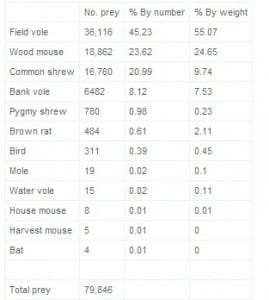Content of pellets from breeding and roost sites in Southern England (from this study)
“Bird remains were not identified to species, and a figure of 20 g has been used for the liveweight equivalent of a bird. Average weights per species used in calculation are as follows: mole 70 g; common shrew 8 g; pygmy shrew 4 g; ‘bat’ 6 g; bank vole 16 g; field vole 21 g; water vole 100 g; wood mouse 18 g; harvest mouse 5 g; house mouse 12 g; brown rat 60 g; ‘bird’ 20 g.
Between 1983 and 1985 members of the Banbury Ornithological Society took part in the so-called Domesday Project, where the twelve 10 km squares identified as the Society’s study area were surveyed to determine land use. Over the study area, 53% was arable, 35% permanent pasture and 8% ley (rotational grassland)”
This table shows the results of dissecting 23058 pellets, which I could compare to outcomes of similar studies and see if I can build up a picture of what to expect from the pellets I dissect.
The study also states that there was a negative relationship between the Field Vole and Wood Mouse, indicating that the Wood Mouse may replace the Field Vole in the diet of the Barn Owl when the vole is less available. This suggest that the availability of field voles may be less important for breeding success than is stated by the Shawyer book.

